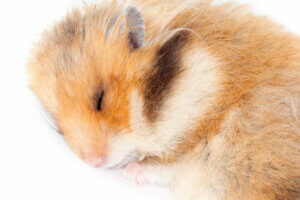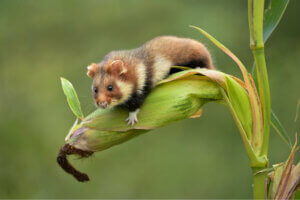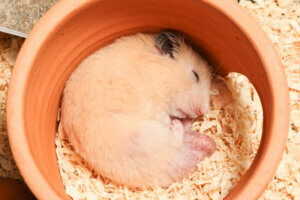Do Hamsters Hibernate?

In the wild, hamsters usually hibernate, but as pets they don’t. This can be explained by the stability of the temperature and the abundance of resources they have in their artificial environment. They don’t need to decrease their metabolic activity to save energy, as this is the optimal environment for them.
These animals are the most popular rodents among domestic pets. The Syrian hamster, the Russian hamster, and the Roborowski dwarf hamster are some of the most popular as pets. Therefore, it’s natural for a keeper to wonder at some point if his or her pet will hibernate during its lifetime. Here we show you how to avoid this.
What is hibernation?
Hibernation is a state of continuous lethargy that some animals undergo during the winter season. During this period, the animal’s metabolism drops to minimum levels. Likewise, the respiratory and heart rate, as well as the temperature, also decrease.
In this phase, these animals don’t eat, drink, urinate, or defecate, because they remain immobile and some of them —like the brown bear— stay this way for long periods of time. As surprising as it may seem, this species remains dormant between 150 and 210 consecutive days. This means that the animal spends more time asleep than awake per year.
Hibernation is hormonally induced. The inner biological clock is involved in this phenomenon, preparing the animal to hibernate in response to certain environmental conditions, such as drops in temperatures or food shortages.
Before winter, when the climate is favorable and food is abundant, animals consume great amounts of food rich in calories and store the excess as fat in the adipose tissue. As you can imagine, they’re preparing for the dark times ahead.
This allows many species of mammals to spend the whole winter “sleeping” in their burrows or shelters. Thus they don’t have to go out to look for food in times when it’s scarce and temperatures are very low.
The energy necessary to maintain basic vital signs is generated by the fat reserves that the animals have previously accumulated. Additionally, this serves as an insulator from the cold.
Not all animals hibernate, nor do all hibernating animals hibernate in the same way.

Can hamsters hibernate?
Like many small mammals, hamsters can hibernate, in fact, hamsters hibernate in their natural state. However, the conditions of a wild environment are very different from those in a cage at home.
Hibernation is a physiological phenomenon, but depends on external conditions. In nature, hamsters start preparing for hibernation when the temperature drops below 15°C (59°F).
Another important factor inducing hibernation in hamsters is the amount of light per day. Fewer hours of light and a drop in temperature indicate the change of the season. Therefore, this climatic change mark the time for the animal to prepare for the winter rest.
A hamster kept in cold and dark conditions is more likely to hibernate than one in a cold but brightly lit environment for more than 12 hours a day. Other important factors triggering this behavior are food supply, isolation, and stress.
How to tell if a hamster is hibernating
It’s unusual for a domestic hamster to hibernate, but, if conditions aren’t favorable, it can do so. In this state, it’s easy to believe that the animal has died, but its vital signs —even if slowed down— are maintained.
During deep hibernation, the animal’s heart rate drops to only four beats per minute. Also, its breathing rate may drop to only one breath every two minutes.
Also, the animal adopts a cuddled-up posture, with limbs somewhat more rigid than normal. However, these limbs can easily be extended by manipulating them a little. On the other hand, the whiskers can contract in a subtle way if the keeper touches them.
If the animal were dead, its body would be rigid — corresponding to rigor mortis — and wouldn’t show any sign of life after 24 hours at a temperature of 20°C (68°F) or, failing that, after any manipulation by its keeper.
How can I prevent my hamster from hibernating?
Everything indicates that the more severe the environment, the more likely that the animal will hibernate. To prevent a hamster from going into hibernation, it’s necessary to create favorable environmental conditions. This is possible by taking into account the following parameters:
- A temperature above 15°C (59°F)
- Enough food and water
- Light for at least 12 hours a day
- Interact with the animal and provide environmental enrichment

As we have seen, we can prevent the hamster from hibernating by fulfilling a series of very simple conditions. With an adequate environmental temperature and abundant food, you can enjoy the energetic activity of this small rodent during its entire life cycle.
In the wild, hamsters usually hibernate, but as pets they don’t. This can be explained by the stability of the temperature and the abundance of resources they have in their artificial environment. They don’t need to decrease their metabolic activity to save energy, as this is the optimal environment for them.
These animals are the most popular rodents among domestic pets. The Syrian hamster, the Russian hamster, and the Roborowski dwarf hamster are some of the most popular as pets. Therefore, it’s natural for a keeper to wonder at some point if his or her pet will hibernate during its lifetime. Here we show you how to avoid this.
What is hibernation?
Hibernation is a state of continuous lethargy that some animals undergo during the winter season. During this period, the animal’s metabolism drops to minimum levels. Likewise, the respiratory and heart rate, as well as the temperature, also decrease.
In this phase, these animals don’t eat, drink, urinate, or defecate, because they remain immobile and some of them —like the brown bear— stay this way for long periods of time. As surprising as it may seem, this species remains dormant between 150 and 210 consecutive days. This means that the animal spends more time asleep than awake per year.
Hibernation is hormonally induced. The inner biological clock is involved in this phenomenon, preparing the animal to hibernate in response to certain environmental conditions, such as drops in temperatures or food shortages.
Before winter, when the climate is favorable and food is abundant, animals consume great amounts of food rich in calories and store the excess as fat in the adipose tissue. As you can imagine, they’re preparing for the dark times ahead.
This allows many species of mammals to spend the whole winter “sleeping” in their burrows or shelters. Thus they don’t have to go out to look for food in times when it’s scarce and temperatures are very low.
The energy necessary to maintain basic vital signs is generated by the fat reserves that the animals have previously accumulated. Additionally, this serves as an insulator from the cold.
Not all animals hibernate, nor do all hibernating animals hibernate in the same way.

Can hamsters hibernate?
Like many small mammals, hamsters can hibernate, in fact, hamsters hibernate in their natural state. However, the conditions of a wild environment are very different from those in a cage at home.
Hibernation is a physiological phenomenon, but depends on external conditions. In nature, hamsters start preparing for hibernation when the temperature drops below 15°C (59°F).
Another important factor inducing hibernation in hamsters is the amount of light per day. Fewer hours of light and a drop in temperature indicate the change of the season. Therefore, this climatic change mark the time for the animal to prepare for the winter rest.
A hamster kept in cold and dark conditions is more likely to hibernate than one in a cold but brightly lit environment for more than 12 hours a day. Other important factors triggering this behavior are food supply, isolation, and stress.
How to tell if a hamster is hibernating
It’s unusual for a domestic hamster to hibernate, but, if conditions aren’t favorable, it can do so. In this state, it’s easy to believe that the animal has died, but its vital signs —even if slowed down— are maintained.
During deep hibernation, the animal’s heart rate drops to only four beats per minute. Also, its breathing rate may drop to only one breath every two minutes.
Also, the animal adopts a cuddled-up posture, with limbs somewhat more rigid than normal. However, these limbs can easily be extended by manipulating them a little. On the other hand, the whiskers can contract in a subtle way if the keeper touches them.
If the animal were dead, its body would be rigid — corresponding to rigor mortis — and wouldn’t show any sign of life after 24 hours at a temperature of 20°C (68°F) or, failing that, after any manipulation by its keeper.
How can I prevent my hamster from hibernating?
Everything indicates that the more severe the environment, the more likely that the animal will hibernate. To prevent a hamster from going into hibernation, it’s necessary to create favorable environmental conditions. This is possible by taking into account the following parameters:
- A temperature above 15°C (59°F)
- Enough food and water
- Light for at least 12 hours a day
- Interact with the animal and provide environmental enrichment

As we have seen, we can prevent the hamster from hibernating by fulfilling a series of very simple conditions. With an adequate environmental temperature and abundant food, you can enjoy the energetic activity of this small rodent during its entire life cycle.
All cited sources were thoroughly reviewed by our team to ensure their quality, reliability, currency, and validity. The bibliography of this article was considered reliable and of academic or scientific accuracy.
- Charles P. Lyman, and Paul O. Chatfield. Physiology of Hibernation in Mammals.
- The Golden Hamster – its Biology and Use in Medical Research Chapter 3 Hibernation and Effects of Temperature Roger A. Hoffman.
This text is provided for informational purposes only and does not replace consultation with a professional. If in doubt, consult your specialist.








